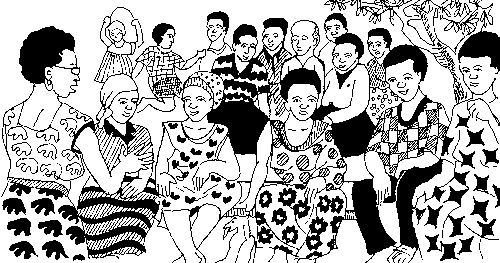Tweet
Translations:
'العربية / al-ʿarabīyah
Bahasa Indonesia
বাংলা / Baṅla
Български език
Català
中文 / Zhōngwén
English
Español
Filipino/Tagalog
Français
Ελληνικά / Elliniká
हिन्दी / Hindī
Italiano
Português
Română
Türkçe
Other formats:
Other Pages:
Modules
Site Map
Key Words
Contact
Utility Documents
Useful Links
BUILDING A CREDIT ORGANIZATION
by Phil Bartle, PhD
Module Introduction
Documents Included in this Credit Module
- Micro Enterprise Scheme, a brief overall description;
- Building a Credit Organization, workshop handout;
- Group Formation and Development, tips on organizing groups;
- Forming Trust Groups, notes about trust groups for participants;
- Savings Mobilization, encouraging the group to save for building credit;
- Some Forms, form models for making your own.
When the community wants income generation, what is their appropriate organization?
So you have gathered the community members, started the healing process of unity organizing, and started to ask about their highest priority problems that they want to work in solving. Perhaps they do not want a latrine or school, or they have just built one and want to go on to new issues. "Poverty," they say, "is the biggest priority. We want to fight it with income generation."
As you learned in other community mobilizing, you encourage community decision making, but do not automatically or passively accept their first suggestions. See Revealing Hidden Resources. Your challenges and dialogue are important in helping them clearly refine their objectives, and learn that there are alternative solutions which they can consider.
Income generation is a sector that is cluttered with failures and disasters. Some well meaning charity agencies handed out hundreds of sewing machines to refugees, for example, and the only income that was generated was when the beneficiaries sold them.
The "Principles" module explains why gifts and grants do not work, and why a combination of credit (loans) at available rates of interest, plus management training (in credit management and business) is the best approach. You do not dictate to them how to attack the problem of poverty but, armed with the knowledge of those principles, you discuss with them the principles of wealth generation (in contrast to mere transfer of cash) and how to organize to succeed.
Co-ops, or co-operatives, throughout modern history, have had a mixed success rate. Productive co-operatives, where the organization is set up to engage in a productive activity, like a factory or farm, have not had a huge success rate. Like state farms and factories, in productive co-operatives there are many problems of management and efficiency. Private enterprise has had much greater success in productive organizations. Distribution co-operatives, like a dairy producers' associations, or farmers marketing unions, have had better success.
Credit unions have had even more greater success and in many cases have become genuinely competitive with banks (when member involvement in management is minimized).
Based upon these observations, you describe to your clients a community organization in which there is a co-operative, or organization similar to a co-operative, which can take credit in large packages from a bank, split that credit into smaller packages for its members, and where members, after some management and financial training, use those smaller packages of credit to set up very small, individual, private productive activities.
This combination of private (productive) and co-operative (credit) activities in the organization, along with the training of its members, has had the most success in income generation schemes.
- What is success?
- Real wealth has been generated, not just a transfer of cash;
- Loans have been repaid at a rate of 100 per cent, or close to it;
- The beneficiaries become independent and self reliant;
- They produce value added (wealth) and contribute to the economy and employment; and
- They become integrated into the mainstream formal capital market;
- (not relying only and dependent upon on unsustainable subsidized sources of credit).
If the community group understands these principles, and the strategy for genuine poverty reduction, then your job as mobilizer, is to facilitate and encourage them to organize in the manner described in this scheme. The Scheme, or programme, is described in the Scheme document, and the organization you will set up, and how to do it, is the topic of this module.
The Micro Enterprise Scheme is a brief, overall description of the set-up, its structure, function of trust and umbrella groups, and the integration of training with the offering of credit.
The Building a Credit Organization is a two page workshop handout describing the organization that you will aim to set up.
Group Formation and Development (from the handbook) includes tips on organizing groups for wealth generation.
Forming Trust Groups is composed of notes for participants.
The Savings Mobilization document gives you the basic characteristics of saving, for you to encourage the group to save for building credit.
The Forms document provides you with some model forms that will guide you in making your own specific forms.
Taken together, the documents in this module will help the facilitator and the participants to envisage, set up, organize, and run a credit organization for the creation and development of private micro enterprise.
––»«––
Forming the Trust Groups:
 |